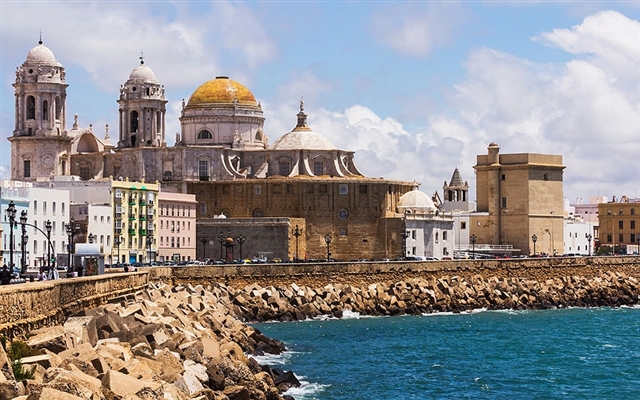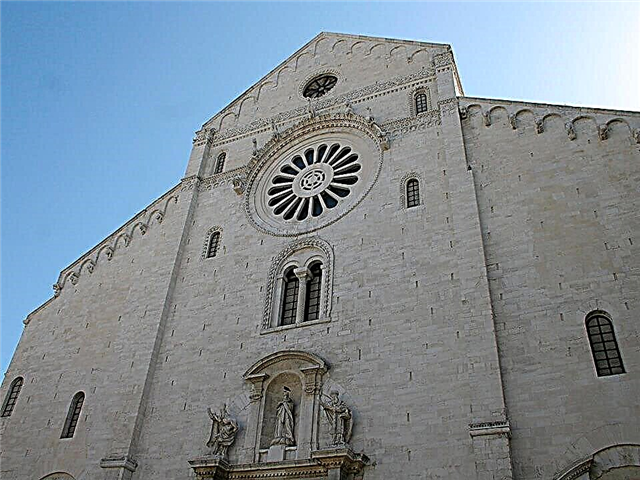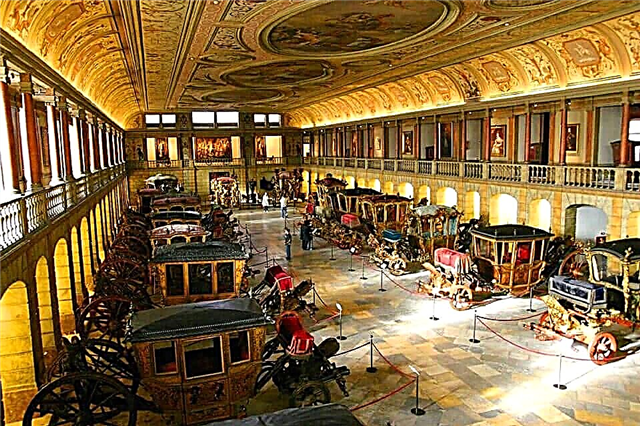Steep staircases, hilly landscapes, funiculars, bohemian neighborhoods, patterned cobblestone paths, pleasant atmosphere, tiny parks - you need to spend at least one day here to get to know Lisbon from the inside. What to see in Lisbon in one day on your own and what must-see places? All the answers are in our guide.
Walk on a vintage tram number 28
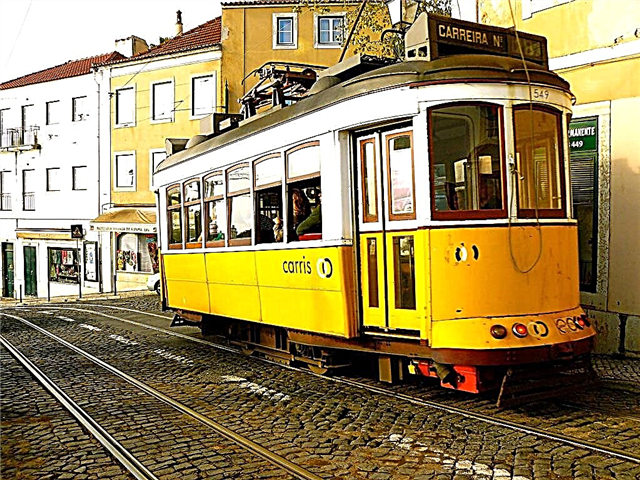
Let's start our walk with unusual rides on a rare tram that follows route 28. Do not think that this is entertainment for tourists, you will also meet locals on the tram. It's public transport, after all. The uniqueness of this tram is its age. You will be surprised when you find out that it is more than 100 years old, and its appearance has never been modernized. You will not confuse a tram with any other, because its "trick" is small yellow (sometimes red) cars. The interior is trimmed with wood and the seats are upholstered in leather.
Tram number 28 travels according to the principle “the quieter you go, the further you will be” and never breaks it. If you delve into history, you can find an interesting fact. In the 80s, they wanted to liquidate this unique tram, which had many interesting routes, since the conscious citizens did not allow this mistake to be made. Thanks to their staunch position, it was decided to change only its route network, since then it has been walking along the central streets, allowing tourists to take a sightseeing tour.
So, hop on the tram in Piazza Martin Moniz and you can enjoy the beauties of the city up to Piazza Orica, but we recommend getting off at Miradora di Santa Lucia. Another small but useful tip, so as not to spoil the experience, try to avoid rush hour. The best time for this adventure is early morning or late evening.
Observation deck of the fortress of St. George
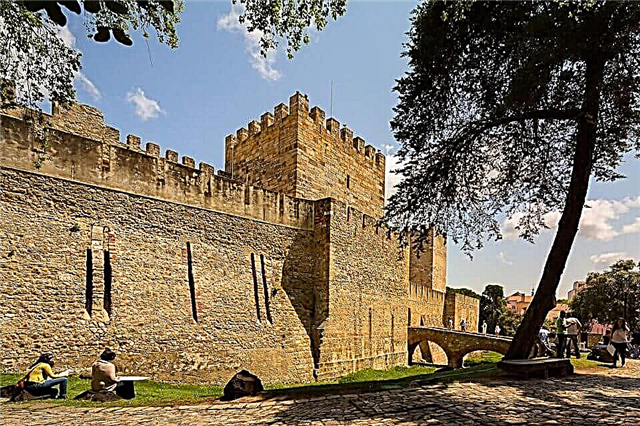
Now is the time to take a little walk. We keep the direction up or, if it’s completely lazy, then take the bus that follows route number 37. It is important for us to get to the observation deck of the fortress of St. George. It can be seen from anywhere in the city, so it is impossible to miss. Since the fortress is one of the main attractions of the city, you will naturally have to pay for the entrance.
You should not spare money, especially since the price of the issue does not exceed 8.5 euros for an adult ticket. You can, if necessary, if the budget is very limited, cheat and impersonate a student if you are not. But at the checkout, they will definitely ask you to present your student ID. At this point, you can practice your persuasion and acting skills.
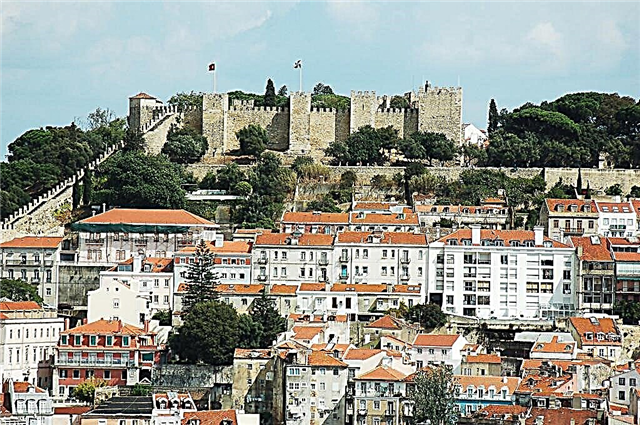
The castle itself once had a very brutal appearance, but today only the walls and some individual buildings have survived. But this is not the main thing, because here you can accidentally meet peacocks and smile when they start to resent the close attention of curious travelers. At this point, they are very funny.
If you visit the castle on the weekend, then there is a high probability that you will become a spectator of an interesting event or even an active participant in it. So, you can, for example, learn how to shoot a crossbow. First of all, of course, we are interested in the gorgeous views that open up to the Tagus River and the Alfama area, the Monastery of San Vicente de Fora.
Now is the time to leave the cradle of Lisbon. Descending is much easier than climbing, so we speed up and change to a tram that will take us to the Belem area. We recommend taking a break from gadgets while on the road and paying attention to the impressive April 25th Bridge, which is 5 kilometers long.
Bridge named April 25
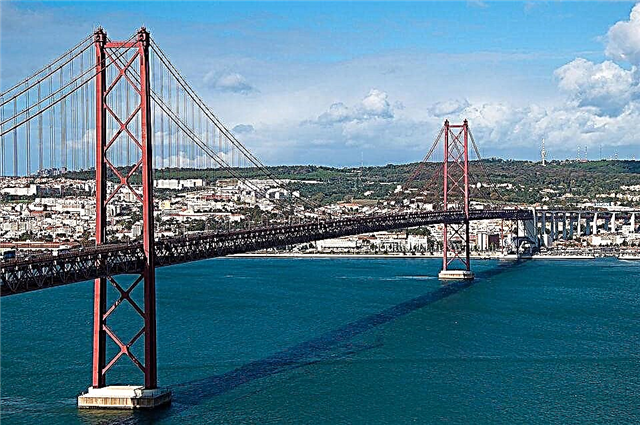
It is one of the visiting cards, reminiscent of the legendary "Golden Gate" in San Francisco. The structure is a two-kilometer suspended structure that connects the northern and southern banks of the Tagus River. The elegant structure amazes with the grandeur of engineering. The deck of the bridge rises above the water level at a height of 70 meters. Heavy steel cables are suspended between two imposing reinforced concrete pylons. Attached to these cables are vertical beams on which the roadbed is suspended.
The grand opening took place in 1966. The building was named after the dictator Antonio Salazar. After a bloodless military coup that ended the authoritarian regime, the townspeople named the bridge April 25 to mark the day of the Red Carnation Revolution. Traffic on the bridge is available for both road and rail transport.
Jeronimos

In the area of Belém, Jeronimos deserves our attention, which is a symbol of the country's prosperity during the Age of Discovery. It's hard to believe, but once there was a chapel of Heinrich the Navigator. Do you know who visited her? Vasco da Gama himself. After returning to this very place, he was met by King Manuel I.
Jeronimos amazes the imagination with its solemn and majestic decoration of both exteriors and interiors. The delicate beige facade of the main body of the building stretches 300 meters in length. Built of sandstone, it is richly decorated with lacy stone carvings, bas-reliefs, ornate ornaments, stucco, buttresses, pinnacles and sculptures. The structure is crowned with soaring Gothic towers and a massive dome. Noteworthy is the square inner courtyard, surrounded by a two-story gallery with an intricate arcade. Each column is decorated with unique carvings depicting coils of ropes, shells and sea creatures.
The interior features a vaulted ceiling. It seems to be tightened with an openwork stone web. Narrow stained glass windows saturate the interior of the basilica with golden light. Carved slender columns, masonry, iconographic symbolism and painted arches evoke a blessed feeling. The cathedral houses the Vasco da Gama sarcophagus, as well as the tombs of the Portuguese kings.
Do not rush to leave this place, because here you will also be interested in the Torre de Belém tower.
Torre de Belém Tower
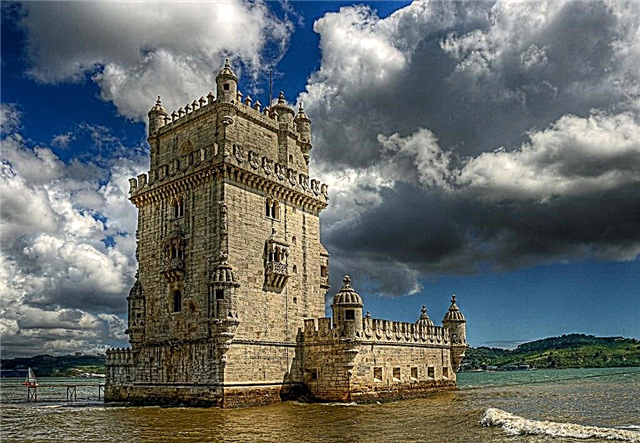
The remarkable structure stands on a river bank in a picturesque place in the historical district of Belém. The base of the tower is a basalt rock. The four-story building was erected at the beginning of the 16th century as a defensive fortress. The exterior of Torre de Beden harmoniously combines the architectural elements of Moorish culture with the fiery Gothic of the traditional Portuguese Manueline style.
The 35-meter-high rectangular tower is decorated with ribbed domes, battlements, openwork balconies, a Venetian arcade, double windows and fine stone carvings. The building is adjoined by a massive bastion with an open terrace surrounded by Arabian turrets. Austere laconic halls of casemates with a vaulted ceiling are hidden behind the elegant facade. Artillery pieces are housed here, reminding visitors of the true purpose of the fort.
Belensky Palace
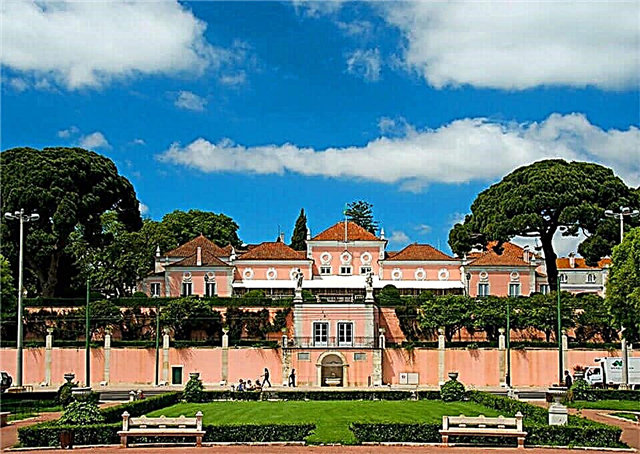
The official residence of the President of Portugal is the National Palace of Belem. Dating back to the 16th century, this magnificent historic building served as a guesthouse for the royal family. A rather modest architectural ensemble consists of five interconnected buildings. The buildings of different heights are painted pink and topped with four-pitched roofs.
The main decorations of the facades are snow-white stucco details and colorful tiles depicting epic scenes from the life of mythological heroes.The side buildings form a terrace divided by balustrades. The abundance of greenery gives the palace a unique appeal. On the third Sunday of each month, a solemn change of the guard of honor takes place in the courtyard of the residence.
It will be interesting to visit the "Water supply hall" located at the entrance to the palace. The name of the premises was born from two gutters. The floor is decorated in black and white. The walls are lined with colorful azulejo tiles, creating picturesque panels.
Monument to the Discoverers
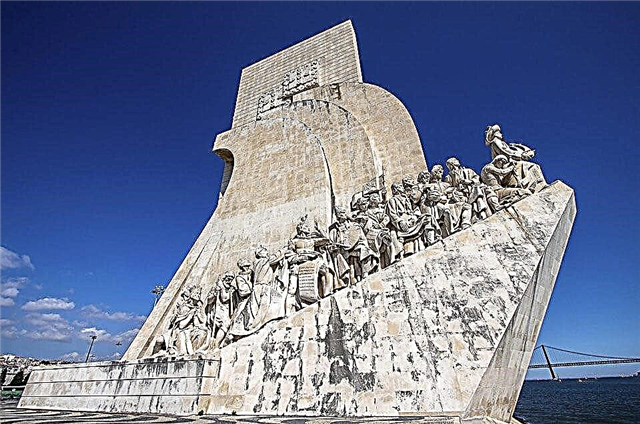
On the banks of the Tagus River, there is a grandiose monumental monument dedicated to significant figures of the era of the great geographical discoveries. The majestic sculptural composition is made of pink stone, limestone and concrete. The legendary monument is a caravel with sails spread out in the wind. The height of the stylized stone ship reaches over 50 meters. The monument was erected in 1960.
On both sides of the upward-directed deck of the caravel, there is a series of sculptures by prominent Portuguese, whose names are inextricably linked with the discovery of new sea routes. Among them are captains, seafarers, monarchs, cartographers, writers, scientists, artists, missionaries and many other explorers of the overseas lands. The group of famous Portuguese is headed by Prince Henry, who is the main organizer of long-distance expeditions. There are 32 statues in total.
Each meticulously detailed sculptural figure holds objects that symbolize the activities of the discoverers. Various old navigation devices are noteworthy. At the foot of the monument is a square paved with tiles with patterns in the form of wavy patterns. Here you can see a huge marble mosaic "Rose of the Winds" with a diameter of 50 meters. In the center of the panel is a large-scale planisphere showing the routes of the Portuguese caravels.
National Carriage Museum
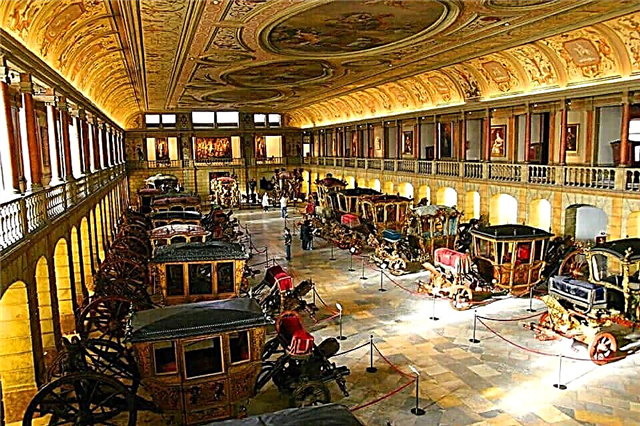
A splendid collection of vintage carriages is on display at the Lisbon Carriage Museum. Unique vehicles of the 16th-19th centuries are on display for the general public. The museum collection houses authentic Portuguese, Italian, French and Austrian horse-drawn carriages that belonged to royalty, nobles, ambassadors and influential nobles.
An impressive collection of carriages can be seen both in the modern pavilion and in the historic building. The new building is located within walking distance from the old building. A small part of the exposition is located in the equestrian arena of the eastern wing of the Belensky Palace, erected in 1786. The luxurious interiors of the grand hall, 50 meters long, correspond to the amazing exhibits exhibited here.
The high ceiling is covered with picturesque frescoes. The room is surrounded by an arched gallery with a balustrade.
Of particular interest are the perfectly preserved carriages, which are true works of art. The crews have a mesmerizing finish. They are adorned with patterns, ornaments, carved figured details with gilding, velvet and fringe, as well as intricate accessories and statues.
Trading area
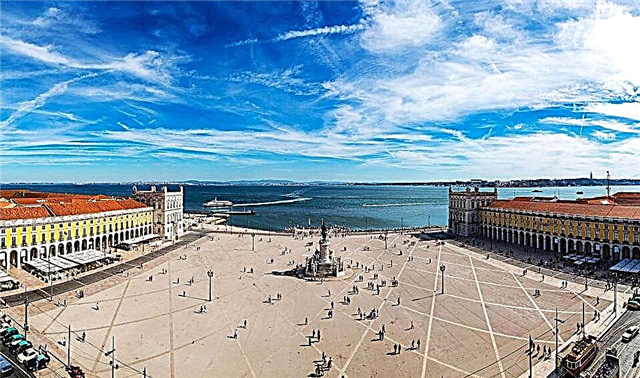
For those who are limited in time and strive to explore the city in one day, we recommend that you proceed to the tram again and head back to the center, or rather to the Arc de Triomphe and the Market Square, which is rightfully considered one of the most beautiful in the city. This iconic historical site was of great importance for the active development of Lisbon. It was from here that caravels set off on long sea voyages. A marina with a marble staircase hosted foreign ships bringing in all kinds of exotic goods.
Before the devastating earthquake of 1755, a pompous royal palace complex rose on the square. The raging elements swept off the face of the earth all the luxurious coastal buildings. After the restoration of the territory, new administrative buildings were erected here, in which the regulation of foreign trade relations between Portugal and the states of Europe, as well as the Asian, American and African colonies was carried out.
The wide quadrangular square is striking in its size and architectural solutions. It is surrounded on three sides by symmetrical structures adorned with shady arcade galleries. In the center, on a high pedestal, there is a bronze equestrian statue of King Jose I.
Triumphal Arch
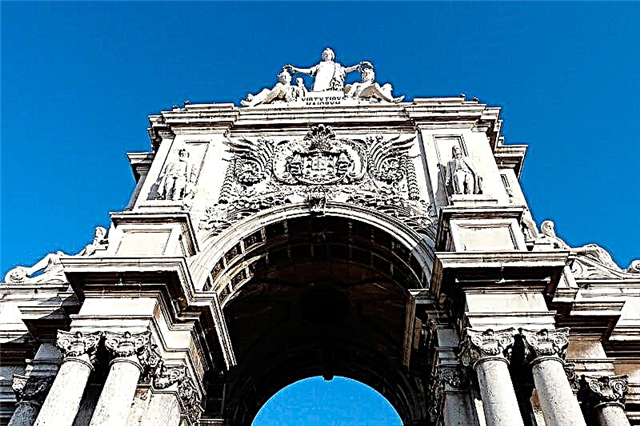
The pearl of the Market Square is the monumental Arc de Triomphe. The majestic structure was laid in 1775, 20 years after the catastrophic earthquake. Due to political turmoil, the construction of the monument was completed only in 1873. Outstanding sculptures worked on the creation of this masterpiece, which in their works sought to emphasize the steadfastness of local residents before the blows of the elements.
The 30-meter-high single-span arch attracts tourists with its unusually sophisticated beauty. The architectural creation is crowned with an allegorical sculptural composition, symbolizing Genius, Glory and Courage. On the facade of the building you can see marble statues of famous Portuguese, including the navigator Vasco da Gama, the Marquis of Pombal, the monk Nunu Pereira and many others. The arch is decorated with columns, bas-reliefs, ornate patterns and clocks framed by exquisite stone carvings.
With the onset of dusk, it takes on a special charming appearance. Colorful illumination envelops the building with colorful lights. At the top of the arch is an observation deck, to which two narrow spiral staircases and an elevator lead. Can you imagine what kind of view you will see? Beyond words!
Nearby you will find a very colorful place - the legendary Café Martinho da Arcada, which has been welcoming visitors since 1782. It is worth mentioning that Portuguese writers and other creative personalities loved to while away the time here, waiting for the Muse.

To find out more information about local attractions and buy souvenirs for friends, we recommend going to the western part of the square, to the main tourist office. If you are fortunate enough to be here on the weekend, then you can see the performances of street performers. Double-decker buses also leave from the square, on which you can see the most significant sights in a few hours.
Now a small fly in the ointment. This information applies not only to the Commerce area, but also to the entire center. Be careful if a stranger offers to try and buy drugs. It's better for you not to know how all this can end. Drugs are illegal in this country.
Elevador di Santa Justa

We continue our journey. From the square we head north. So we can get to the Baixa quarter. Here we have an old elevator, very beautiful - Elevador di Santa Justa. It is an ancient vertical elevator that connects the Baixa seaside district with the high-rise neighborhoods of the city. The hilly countryside of Lisbon has caused difficulties for local residents from time immemorial. Only physically hardy Lisbonians could regularly overcome the steep slopes. At the beginning of the 20th century, a magnificent monument to engineering was erected, designed to alleviate the fate of the townspeople and guests of the capital.
The graceful steel structure rises up to 45 meters. Many neo-Gothic decorative elements can be seen on the facade of the building. Openwork arcades and slender columns create the impression of an airy structure. The base of the tower is supported by four columns. Two elevator cabins are finished with wood paneling and mirrors. Climbing up, tourists follow to the observation deck, from where the picturesque landscapes of the city open.
There is also a little trick. Although it is an elevator, it is part of the public transport system.Have a tram ticket? Then you can safely use it. Let's not linger and continue our journey. It will not take long to walk, because in a few minutes you will find yourself in the very heart of Lisbon, at Rossio Square. The official name is Piazza Don Pedro IV.
Rossio Square
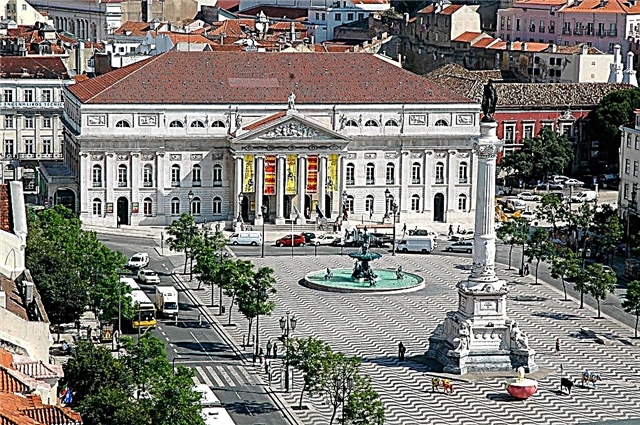
Its foreseeable history is more than 500 years old. In the medieval era, the square was the seat of the Inquisition tribunal, and public executions were also carried out. From time immemorial, riots and festive festivities were held here. After the devastating earthquake, Rossio was built up with an architectural ensemble in the style of the Portuguese Renaissance. For many tourists, it is from here that acquaintance with the sights begins.
Lined with wave-like mosaic tiles of black and white cobblestone. The figured paving was created so that sailors who went ashore could quickly rebuild their vestibular apparatus and adapt to walking on land. Rossio is surrounded by old mansions that now house hotels, restaurants and shops. Among the architectural monuments, the classic building of the national theater stands out. Its facade is decorated with a monumental portico with six columns and a pediment.
The elegant structure of the railway station is amazing. The central entrance is decorated with horseshoe-shaped arches with exquisite stone lace. The openwork balustrade of the roof, narrow buttresses, tiled inserts and Gothic pinnacles make an indelible impression. In the center there is a sculpture of King Pedro IV, mounted on a high pillar. The base of the pedestal is decorated with marble female figures that represent the qualities inherent in monarchs. It is strength, justice, wisdom and restraint. Two bronze fountains with sculptural compositions give the area a special solemn charm.
If you haven't had time to eat yet, then head up the stairs to the west of Praça do Rossio. Here you will find a place where you can dine deliciously and enjoy your vacation in a pleasant environment. Have you refreshed? Great, because there are still so many interesting things ahead.
Alfama District
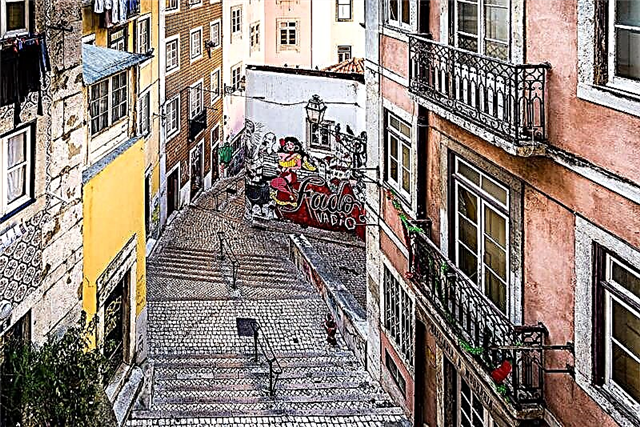
Now you need to cross the Don Pedro IV square to the east, where you can take the funicular. It will take you to the Alfama area. Enjoy the views and beauties, especially since there is no sense in rushing anymore, you have already seen all the main attractions. The evening can be spent at the bar tasting the ginjinha cherry liqueur. This can be done in any of the local bars. We recommend having a fun evening and a delicious dinner in the Barrio Alto quarter.
Where to stay

If you plan to stop for more than one day, you can pre-book accommodation, although experienced travelers recommend that you resolve the issue on the spot. The fact is that in Lisbon you can easily accommodate in a guesthouse, but they practically do not post their offers on aggregator sites. Despite the modest atmosphere, the guesthouses have undeniable advantages - price and convenient location. If you don't want to waste time searching, we recommend that you pay attention to the following options:
Alojamento Local Santo Tirso is easy to find as it is located in the main square of Lisbon, Rossio. It is also one of the most budget-friendly accommodation options in the city center.
SANA Rex Hotel 3 *. The hotel is located in the center and offers simply stunning views of the park and the historic center.
Hotel Metropole 3 *. A chic option for those who do not skimp on amenities. The hotel is located in the heart of the city.
Hope our travel guide will help you have an unforgettable day in Lisbon.





